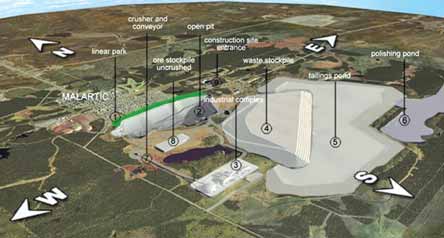Osisko Mining received Quebec government
authorization in late August 2009 to
complete development of its Canadian
Malartic open-pit gold project and is proceeding
with construction of the mine and
mill. Construction is expected to take 18
months, and the project is planned to be
fully operational by the second quarter of
2011. Production is planned to average
591,000 oz/y of gold over 10 years of operation
based on current proven and probable
reserves of 6.28 million oz and will exceed
600,000 oz/y in the initial years of operation.
Production costs of $319/oz will be in
the lowest quartile of world gold producers.
In addition to current reserves,
Canadian Malartic’s measured and indicated
resources stand at 3.6 million oz, and
inferred resources total 720,000 oz. Five
mineralized zones outside the planned pit
and additional targets are currently being
explored by six diamond drills. Drilling during
2009 will total about 200,000 m.
The Canadian Malartic mine is located
at the southern edge of the town of
Malartic, and mine development required
movement of a neighborhood to make way
for mining operations. This aspect of the
project was 98% complete as of
September 2009. Drilling and blasting
activities have been designed to control
blast induced vibrations and airblast overpressure
on the town.
With overall investment of nearly C$1
billion, the Canadian Malartic project will
create about 800 direct jobs during construction
and 465 permanent direct jobs
during the 10 years of operation. A large
majority of the new jobs will be taken by
residents of the town of Malartic and the
Abitibi-Témiscamingue region.
Canadian Malartic mine planning is
based on an ore resource of 183.3 million
mt at an average grade of 1.07 g/mt gold.
Mine production will total 150,000 mt/d of
ore and waste, and the mill will process
55,000 mt/d of ore. Access to the pit will
be via a 35-ft-wide, 10% decline ramp
designed to accommodate Caterpillar
793F haul trucks. The haulage fleet initially
will include 12 units and is planned
to increase to 22 units by the sixth year of
operation due to the deepening of the pit
and higher dump levels for waste.
Two 28-m3 O&K RH340-B hydraulic
shovels will load ore and waste. During the
second year of operation, a 21-m3 O&K
RH200 hydraulic shovel will be added to
increase the mining rate from 51 million
mt/y to 64 million mt/y. A Cat 994F HL
front-end wheel loader will complement the
shovels and re-handle ore from the stockpiles.
Ancillary equipment will include two
Cat 16 M graders, four track-type Cat D10T
dozers, one Cat 834H wheel dozer, two
water trucks, and other support equipment.
The processing flowsheet includes gyratory
crushing and SAG and ball mill grinding.
Cyclone overflow from the tertiary
grinding circuit will be thickened to about
50% solids and fed to a leach tank circuit,
where oxygen will be injected to increase
the kinetics of the dissolution of gold in the
leach circuit. This slurry will flow by gravity
to two parallel sets of carbon-in-pulp
(CIP) pump cell carousels, where activated carbon will absorb the gold in a countercurrent
flow arrangement.
The loaded carbon will be screened
from the slurry and transferred to the stripping
circuit, where the gold will be
stripped into a gold pregnant solution and
deposited in the form of a sludge onto
stainless steel cathodes. The deposited
gold sludge will be pressure washed to the
bottom of the electrowinning cells and
subsequently filtered, dried, and poured
into gold doré bars.
The stripped carbon will be reactivated
in two kilns and re-used in the carousel
pump cell CIP circuit. The slurry from the
last stage of the tank series in the
carousels will be barren in gold and will be
directed to the tailings thickener.
The original Canadian Malartic deposit
was discovered in 1926, and underground
mine production started in 1935. The
mine closed in 1965 after producing
1,076,000 oz of gold from 9.93 million mt
of ore grading 3- to 6-g/mt gold. Osisko
acquired the property in 2004.
As featured in Womp 2009 Vol 08 - www.womp-int.com


